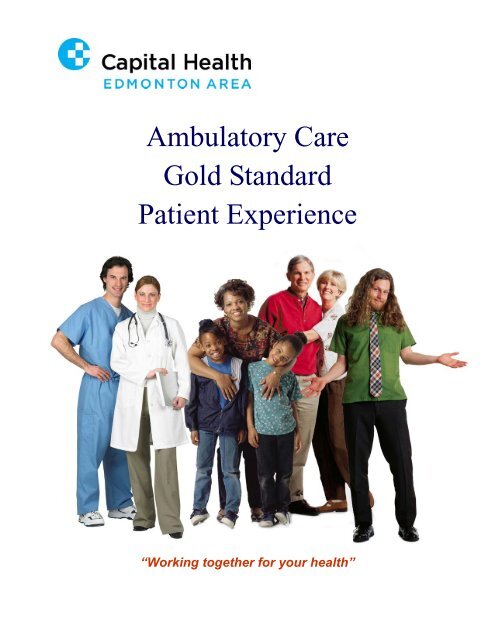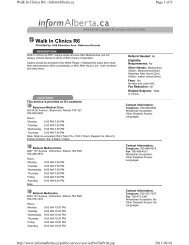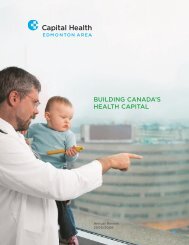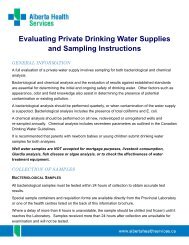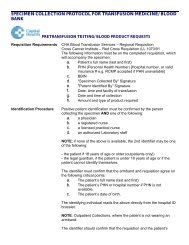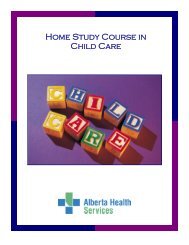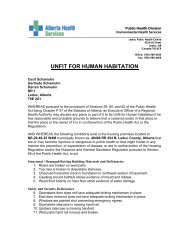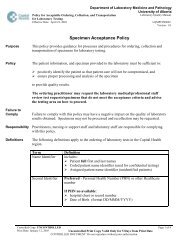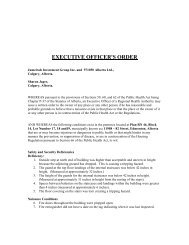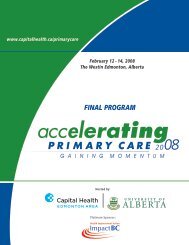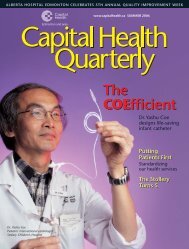Ambulatory Care Gold Standard Patient Experience - Capital Health
Ambulatory Care Gold Standard Patient Experience - Capital Health
Ambulatory Care Gold Standard Patient Experience - Capital Health
You also want an ePaper? Increase the reach of your titles
YUMPU automatically turns print PDFs into web optimized ePapers that Google loves.
<strong>Ambulatory</strong> <strong>Care</strong><br />
<strong>Gold</strong> <strong>Standard</strong><br />
<strong>Patient</strong> <strong>Experience</strong><br />
“Working together for your health”
Contents<br />
CONTENTS .................................................................................................................................................................2<br />
INTRODUCTION .......................................................................................................................................................3<br />
AMBULATORY CARE INTEGRATION PROJECT JOURNEY .............................................................................................3<br />
PROJECT OBJECTIVES ..........................................................................................................................................3<br />
PROJECT SCOPE ......................................................................................................................................................4<br />
AMBULATORY CARE PROCESS ...................................................................................................................................4<br />
PROJECT APPROACH.............................................................................................................................................4<br />
THE JOURNEY.............................................................................................................................................................4<br />
THE CONCEPTUAL MODEL OVERVIEW ..........................................................................................................5<br />
AMBULATORY CARE - GOLD STANDARD PATIENT EXPERIENCE FRAMEWORK CONCEPTUAL MODEL .......................6<br />
VISION.........................................................................................................................................................................7<br />
AMBULATORY CARE - GOLD STANDARD PATIENT EXPERIENCE VISION ....................................................................7<br />
PRINCIPLES, STANDARDS AND ENABLERS.....................................................................................................7<br />
THE AMBULATORY CARE - GOLD STANDARD PATIENT EXPERIENCE FRAMEWORK...................................................7<br />
PRINCIPLE #1 ............................................................................................................................................................9<br />
I CAN EASILY ACCESS AND SCHEDULE MY CARE AND NAVIGATE THROUGH THE CAPITAL HEALTH SYSTEM. .............9<br />
PRINCIPLE # 2 .........................................................................................................................................................12<br />
MY PROVIDERS SHARE ONE SOURCE OF INFORMATION ABOUT ME AND COORDINATE MY PLAN OF CARE..................12<br />
PRINCIPLE #3 ..........................................................................................................................................................14<br />
I HAVE CHOICES IN MY HEALTH CARE AND MY DECISIONS ARE RESPECTED. .............................................................14<br />
PRINCIPLE #4 ..........................................................................................................................................................16<br />
I KNOW WHAT TO EXPECT AND HAVE INFORMATION AND ASSISTANCE AS I NEED IT.................................................16<br />
PRINCIPLE #5 ..........................................................................................................................................................19<br />
EVERYONE SHARES OWNERSHIP FOR DELIVERING MY GOLD STANDARD EXPERIENCE. ............................................19<br />
PRINCIPLE #6 ..........................................................................................................................................................21<br />
I FEEL COMFORTABLE AND SECURE IN A CARING ENVIRONMENT..............................................................................21<br />
A VISIT TO CAPITAL HEALTH: 2015 ................................................................................................................23<br />
ACCESS AND SCHEDULING .......................................................................................................................................23<br />
ARRIVAL AND REGISTRATION ..................................................................................................................................24<br />
IN ROOM...................................................................................................................................................................24<br />
DISCHARGE ..............................................................................................................................................................25<br />
Page 2 of 25
Introduction<br />
In the fall of 2006, <strong>Capital</strong> <strong>Health</strong> launched one of its top strategic initiatives, the <strong>Ambulatory</strong><br />
<strong>Care</strong> Integration Project. The overall goal of this project is to improve the patient experience at<br />
<strong>Capital</strong> <strong>Health</strong>. <strong>Capital</strong> <strong>Health</strong> is already known for outstanding quality of care and breadth of<br />
services. The challenge is to be known for offering the <strong>Gold</strong> <strong>Standard</strong> patient experience as<br />
well. As depicted below, there are two primary streams of work -- the <strong>Ambulatory</strong> <strong>Care</strong> - <strong>Gold</strong><br />
<strong>Standard</strong> <strong>Patient</strong> <strong>Experience</strong> and EMR/Scheduler.<br />
<strong>Ambulatory</strong> <strong>Care</strong> Integration Project Journey<br />
Integrated Clinical Services Enabled by Advanced Clinical Tools<br />
<strong>Ambulatory</strong> <strong>Care</strong><br />
<strong>Gold</strong> <strong>Standard</strong><br />
Principle(s) Principle(s) Principle(s) Principle(s) Principle(s)<br />
<strong>Standard</strong>s <strong>Standard</strong>s <strong>Standard</strong>s <strong>Standard</strong>s <strong>Standard</strong>s<br />
Enablers (Key Operating Points)<br />
People<br />
Process<br />
Environment<br />
Technology<br />
<strong>Ambulatory</strong> <strong>Care</strong> – <strong>Gold</strong> <strong>Standard</strong><br />
<strong>Patient</strong> <strong>Experience</strong> Project<br />
Clinical Redesign and Transformation<br />
Scheduler / EMR<br />
Technology Implementation<br />
Project Objectives<br />
The objective of the <strong>Ambulatory</strong> <strong>Care</strong> – <strong>Gold</strong> <strong>Standard</strong> <strong>Patient</strong> <strong>Experience</strong> Project is to develop<br />
a framework to enable <strong>Capital</strong> <strong>Health</strong> and their physicians, clinicians and staff to consistently<br />
deliver the ideal patient care experience to all of their patients in ambulatory settings.<br />
The <strong>Ambulatory</strong> <strong>Care</strong> – <strong>Gold</strong> <strong>Standard</strong> <strong>Patient</strong> <strong>Experience</strong> is expected to:<br />
• Enable high quality patient outcomes<br />
• Enable cost effective use of resources<br />
• Enable a high standard relative to patient safety<br />
• Deliver an environment which provides high patient and family/caregiver satisfaction<br />
• Be scalable to the regional level to facilitate effective management of patients across the<br />
continuum of care<br />
Page 3 of 25
Project Scope<br />
The <strong>Ambulatory</strong> <strong>Care</strong> Process as defined for this project is illustrated below:<br />
<strong>Ambulatory</strong> <strong>Care</strong> Process<br />
Access and<br />
Scheduling<br />
Registration<br />
and Check-in<br />
In Room<br />
Discharge<br />
The <strong>Ambulatory</strong> <strong>Care</strong> Process is comprised of four phases and the related People, Process,<br />
Environment and Technology elements:<br />
Access and Scheduling: Includes the request for a referral; locating the appropriate physician<br />
for referral; scheduling an appointment; locating the site/clinic; accessing the provider and/or<br />
information related to the healthcare process; way finding at the site; parking<br />
Registration and Check in: Includes logging the patient into the Admission and Billing system;<br />
logging the patient as arrived at the specific clinic; waiting room processes; waiting room area<br />
In Room: Includes exam room preparation; rooming processes; patient interactions with care<br />
givers; patient preparation for visit. Does not include clinical guidelines or clinical treatment<br />
planning.<br />
Discharge: Includes instructing patient and their designees related to follow up; distribution of<br />
consultative reports; follow up appointment/ diagnostic scheduling<br />
The entire health continuum including acute inpatient care, community care and primary care<br />
and the interplay with ambulatory care were taken into consideration with the design of the<br />
framework. An example of the interplay between ambulatory care and the healthcare<br />
continuum is the communication back to the primary care physician post consultation.<br />
Project Approach<br />
The Journey<br />
A Coordinating Committee was formed to develop the <strong>Gold</strong> <strong>Standard</strong> Framework. Members<br />
included physicians and management, and all sites were represented. As depicted in the<br />
following graphic, the Framework was developed in a six-step process from October 11, 2006 to<br />
January 2, 2007.<br />
Page 4 of 25
<strong>Ambulatory</strong><br />
<strong>Care</strong><br />
<strong>Gold</strong> <strong>Standard</strong><br />
Step 2 Step 3<br />
Step 4<br />
External Scan<br />
Best Practices – <strong>Health</strong>care<br />
Best Practices – Other Industries<br />
<strong>Patient</strong> Feedback<br />
In-clinic <strong>Patient</strong> Surveys<br />
Deep<br />
Dive<br />
Draft<br />
<strong>Gold</strong><br />
<strong>Standard</strong><br />
Review draft<br />
<strong>Gold</strong> <strong>Standard</strong><br />
with Coordinating<br />
Committee and<br />
Selected<br />
Representatives<br />
Refine<br />
principles based<br />
on review with<br />
front line focus<br />
groups<br />
Summit<br />
Step 5 Step 6<br />
Develop<br />
<strong>Standard</strong>s<br />
and<br />
Enablers<br />
Review<br />
and<br />
Approval<br />
Step 1<br />
Internal Scan<br />
Staff Interviews and Focus Groups<br />
Executive Level Interviews<br />
Physician Interviews<br />
Clinic Observations<br />
Structured<br />
Brainstorming<br />
Validation<br />
Session<br />
The Conceptual Model Overview<br />
The <strong>Ambulatory</strong> <strong>Care</strong> - <strong>Gold</strong> <strong>Standard</strong> <strong>Patient</strong> <strong>Experience</strong> Framework consists of principles,<br />
supporting principles, standards, and enablers. Together, they support the delivery of the<br />
<strong>Ambulatory</strong> <strong>Care</strong> – <strong>Gold</strong> <strong>Standard</strong> <strong>Patient</strong> <strong>Experience</strong> to <strong>Capital</strong> <strong>Health</strong> patients.<br />
The conceptual model for the <strong>Ambulatory</strong> <strong>Care</strong> - <strong>Gold</strong> <strong>Standard</strong> <strong>Patient</strong> <strong>Experience</strong> is based<br />
upon a pyramid format. As illustrated below, enablers support the standards and the principles,<br />
which in turn support the vision of the <strong>Ambulatory</strong> <strong>Care</strong> - <strong>Gold</strong> <strong>Standard</strong> <strong>Patient</strong> <strong>Experience</strong>.<br />
Page 5 of 25
<strong>Ambulatory</strong> <strong>Care</strong> - <strong>Gold</strong> <strong>Standard</strong> <strong>Patient</strong> <strong>Experience</strong> Framework<br />
Conceptual Model<br />
<strong>Ambulatory</strong> <strong>Care</strong><br />
<strong>Gold</strong> <strong>Standard</strong><br />
Principle(s) Principle(s) Principle(s) Principle(s) Principle(s)<br />
<strong>Standard</strong>s <strong>Standard</strong>s <strong>Standard</strong>s <strong>Standard</strong>s <strong>Standard</strong>s<br />
Enablers (Key Operating Points)<br />
People<br />
Process<br />
Environment<br />
Technology<br />
Vision:<br />
Principles:<br />
<strong>Standard</strong>s:<br />
Enablers:<br />
A description of what we<br />
want the <strong>Ambulatory</strong><br />
<strong>Care</strong> patient experience<br />
to be<br />
A set of fundamental,<br />
comprehensive, and<br />
required criteria<br />
How achievement of the<br />
principle will be<br />
measured<br />
How the principles will<br />
be achieved<br />
To create the <strong>Ambulatory</strong> <strong>Care</strong> - <strong>Gold</strong> <strong>Standard</strong> <strong>Patient</strong> <strong>Experience</strong> Framework, a consistent set<br />
of definitions for each component of the framework was established. These critical elements<br />
are described below.<br />
• Principles define the set of fundamental, comprehensive, and required criteria for achieving<br />
the <strong>Ambulatory</strong> <strong>Care</strong> - <strong>Gold</strong> <strong>Standard</strong> <strong>Patient</strong> <strong>Experience</strong> vision. Each principle has a subset of<br />
supporting principles that provide the additional detail necessary to operationalize the<br />
overarching principle.<br />
• Each principle has a set of standards to measure the successful implementation of the<br />
overarching and supporting principles. These standards have been quantified and categorized<br />
into short-term, mid-term and <strong>Ambulatory</strong> <strong>Care</strong> - <strong>Gold</strong> <strong>Standard</strong> <strong>Patient</strong> <strong>Experience</strong> goals. The<br />
time frame for each goal will initiate at the end of implementation of the related enabler. Shortterm<br />
goals are those that are expected to be met within 6 months. Mid-term goals are<br />
expected to be accomplished within 6 to 12 months. The standards will be implemented<br />
system-wide to allow for cross comparison and measurement of the system components<br />
against the <strong>Ambulatory</strong> <strong>Care</strong> - <strong>Gold</strong> <strong>Standard</strong> <strong>Patient</strong> <strong>Experience</strong>.<br />
In order to help achieve these principles, a sample set of enablers has been selected as a<br />
result of research of customer service best practices, both internal and external to the<br />
healthcare industry. Enablers are the toolkit of operating points that support achievement of the<br />
principles. The enablers have been categorized into one of 4 areas:<br />
• People: Those enablers that encompass development of or changes to existing job<br />
descriptions, new roles, and behaviours. For example: development of a greeter role (an<br />
individual who is responsible for greeting all patients as they enter the facility) would be<br />
considered a people enabler. This type of enabler will most likely be paired with one of the<br />
other 3 enablers as implementation of a process, environment, or technology enabler may<br />
change current roles.<br />
• Process: Those enablers that encompass development of new processes and/or policies or<br />
changes to existing processes and/or policies. Process enablers can be implemented with or<br />
Page 6 of 25
without Environment and Technology enablers but will most likely have an accompanying<br />
People enabler.<br />
• Environment: Those enablers that encompass changes to the environment. These include<br />
policies related to image strategies, ambiance, design palette, assignment of exam rooms,<br />
layout of physical space, wayfinding, parking facilities and related policies. These enablers<br />
may be paired with any of the three other enablers or may be solely implemented.<br />
• Technology: Those enablers that encompass the implementation of technology. These<br />
include implementation of an automated scheduling system, EMR, new parking meters,<br />
registration kiosks, electronic directories, and other communication or information systems.<br />
The implementation of enablers will be system-wide or site-wide. For example, policy changes<br />
may be made on a system-wide basis to maintain a consistent <strong>Capital</strong> <strong>Health</strong> image. Other<br />
enablers will be selected and implemented specific to the needs of the specific clinic and/or site.<br />
Summarized below is the outcome of applying this conceptual framework to the development of<br />
the <strong>Ambulatory</strong> <strong>Care</strong> <strong>Gold</strong> <strong>Standard</strong> Patinet Expereince.<br />
Vision<br />
<strong>Ambulatory</strong> <strong>Care</strong> - <strong>Gold</strong> <strong>Standard</strong> <strong>Patient</strong> <strong>Experience</strong> Vision<br />
The vision for the <strong>Ambulatory</strong> <strong>Care</strong> - <strong>Gold</strong> <strong>Standard</strong> <strong>Patient</strong> <strong>Experience</strong> must be a powerful<br />
statement of what <strong>Capital</strong> <strong>Health</strong> wants the <strong>Ambulatory</strong> <strong>Care</strong> <strong>Gold</strong> standard to be. Grounded by<br />
<strong>Capital</strong> <strong>Health</strong>’s mission and values, the Coordinating Committee and Project Team developed<br />
the draft vision. While the language still needs to be refined, the Coordinating Committee, with<br />
input from over 100 people, recommends the following vision statement:<br />
“Working together for your health”<br />
Principles, <strong>Standard</strong>s and Enablers<br />
The <strong>Ambulatory</strong> <strong>Care</strong> - <strong>Gold</strong> <strong>Standard</strong> <strong>Patient</strong> <strong>Experience</strong><br />
Framework<br />
At its core, all <strong>Ambulatory</strong> <strong>Care</strong> - <strong>Gold</strong> <strong>Standard</strong> <strong>Patient</strong> <strong>Experience</strong> principles and supporting<br />
principles will support the mission, vision, and values of <strong>Capital</strong> <strong>Health</strong>. The <strong>Ambulatory</strong> <strong>Care</strong> -<br />
<strong>Gold</strong> <strong>Standard</strong> <strong>Patient</strong> <strong>Experience</strong> framework is built on the following assumptions which are<br />
based upon the patients’ basic expectations related to their ambulatory patient care experience.<br />
The framework assumes that all ambulatory patient care experiences will enable and provide for<br />
the patient, at a minimum:<br />
• Safety as dictated by all provincial, federal regulatory requirements and industry best practices<br />
• Quality of <strong>Care</strong> based on evidenced-based research and industry best practices<br />
• Clinical Education and Research<br />
• Shared Responsibility – <strong>Patient</strong>/Provider<br />
• Respect<br />
• Confidentiality and Privacy as dictated by all provincial and federal regulatory requirements<br />
To have the strongest impact and maintain the focus on the patient, the overarching principles<br />
are written from the patient’s perspective. It is assumed that responsibility for the success of the<br />
<strong>Ambulatory</strong> <strong>Care</strong> - <strong>Gold</strong> <strong>Standard</strong> <strong>Patient</strong> <strong>Experience</strong> framework is shared between patients<br />
Page 7 of 25
and their health care teams. Therefore, both patients and health care teams are responsible for<br />
being respectful, setting expectations, and honouring agreements.<br />
The <strong>Ambulatory</strong> <strong>Care</strong> - <strong>Gold</strong> <strong>Standard</strong> <strong>Patient</strong> <strong>Experience</strong> framework follows. Each of the 6<br />
overarching principles has been organized in the following format.<br />
<strong>Ambulatory</strong> <strong>Care</strong><br />
<strong>Gold</strong> <strong>Standard</strong><br />
Principle(s) Principle(s) Principle(s) Principle(s) Principle(s)<br />
<strong>Standard</strong>s <strong>Standard</strong>s <strong>Standard</strong>s <strong>Standard</strong>s <strong>Standard</strong>s<br />
Enablers (Key Operating Points)<br />
People<br />
Process<br />
Environment<br />
Technology<br />
Page 8 of 25
Principle #1<br />
I can easily access and schedule my care and navigate through the<br />
<strong>Capital</strong> <strong>Health</strong> System.<br />
Supporting Principles<br />
• <strong>Patient</strong>s have choices in scheduling their appointments and are able to self schedule<br />
• Appointments are coordinated across multiple providers to support seamless, patient-centred<br />
care<br />
• Access processes are predictable, consistent, logical, and timely (e.g. referral, scheduling, and<br />
registration)<br />
• There is adequate parking and parking fees are consistent<br />
• The facilities are designed for optimal wayfinding, sequential and easy movement<br />
• Clinic operations support patient flow and access<br />
• <strong>Patient</strong>s have the appropriate modes of transportation readily available intra- and inter-site<br />
<strong>Standard</strong>s Short-term Goal Mid-term Goal <strong>Gold</strong> <strong>Standard</strong><br />
• No show rate • 20% decrease in no • 50% decrease in no •
<strong>Standard</strong>s Short-term Goal Mid-term Goal <strong>Gold</strong> <strong>Standard</strong><br />
• There are published<br />
wait time standards<br />
for routine and<br />
urgent appointments<br />
in all clinical areas<br />
• Wait time in waiting<br />
room<br />
• Referring physician<br />
satisfaction<br />
• Overbooked<br />
appointments<br />
• Wait time standards<br />
are met 50% of the<br />
time<br />
• 50% of patients<br />
indicate they are<br />
“very satisfied” with<br />
appointment access<br />
(patient survey)<br />
• <strong>Patient</strong> wait time is<br />
decreased by 50%<br />
• 50% increase in<br />
physicians who are<br />
“very satisfied” with<br />
the referral process<br />
• Decrease<br />
overbooked<br />
appointments by<br />
50%<br />
• Wait time standards<br />
are met 75% of the<br />
time<br />
• 75% of patients<br />
indicate they are<br />
“very satisfied” with<br />
appointment access<br />
(patient survey)<br />
• <strong>Patient</strong> wait is no<br />
longer than 20<br />
minutes post<br />
scheduled<br />
appointment time<br />
• 80% of referring<br />
physicians are “very<br />
satisfied” with the<br />
referral process<br />
• Maximum of 25%<br />
double booked<br />
appointments<br />
• < 24 hours for urgent<br />
care<br />
• < 30 days for routine/<br />
preventive care·0<br />
days for primary care<br />
for third next<br />
available<br />
appointment (IHI)·<br />
• 2 days for specialty<br />
care for third next<br />
available<br />
appointment (IHI)<br />
• 95% of patients<br />
indicate they are<br />
“very satisfied” with<br />
appointment access<br />
(patient survey)<br />
• <strong>Patient</strong> wait is no<br />
longer than 10<br />
minutes post<br />
scheduled<br />
appointment time<br />
• Automated referral<br />
process<br />
• Rate of double<br />
booked<br />
appointments<br />
matches patient no<br />
show rate<br />
Sample Enabler Description Sample Source<br />
<strong>Patient</strong> Navigator<br />
(Appointments)<br />
Staff member dedicated to assisting<br />
patients with making follow up and<br />
referral appointments during the<br />
treatment process<br />
Bumrungrad International,<br />
Bangkok, Thailand<br />
Mayo Clinic, Jacksonville, FL<br />
People<br />
<strong>Patient</strong> Way<br />
Finder<br />
(Directions)<br />
Staff member dedicated to assisting<br />
patients with directions to and within<br />
facilities<br />
Out of industry:<br />
Red Coats: NWA<br />
Transporters<br />
Staff dedicated to transporting patients<br />
within the facility; able to be utilized for<br />
inpatient and outpatient visits<br />
US hospitals<br />
Process<br />
Scheduling<br />
guidelines<br />
<strong>Standard</strong>ized<br />
referral forms<br />
Guidelines that indicate visit length,<br />
instructions to be provided to patients<br />
and other exams or tests to be<br />
scheduled<br />
<strong>Standard</strong>ized referral forms indicating<br />
reason for referral which supports<br />
Jackson Memorial Hospital,<br />
Miami, FL<br />
UC Davis Medical Center,<br />
Sacramento, CA<br />
Page 10 of 25
Sample Enabler Description Sample Source<br />
Technology<br />
Environment<br />
Reduced or<br />
complimentary<br />
parking<br />
Staffing<br />
assignments<br />
Exam Room<br />
assignments<br />
Porter hotline<br />
Electronic<br />
Scheduling<br />
System<br />
<strong>Patient</strong> web<br />
portals<br />
Registration<br />
kiosks<br />
Smart cards with<br />
photo ID<br />
Map kiosks<br />
Designated<br />
parking<br />
Offsite parking<br />
with shuttle<br />
service<br />
Wheelchair<br />
stations<br />
Valet parking<br />
diagnostic results<br />
Reduced parking fees or complimentary<br />
parking for patients<br />
Each physician is provided with the<br />
minimum number of support staff as<br />
defined by best practices<br />
Physicians are assigned a minimum<br />
number of exam/procedure rooms<br />
Red phones at primary entrances<br />
available for patients who direct dial into<br />
a centralized porter dispatch system<br />
A centralized database listing providers<br />
by specialty, credentials, schedule and<br />
available appointment slots<br />
<strong>Patient</strong> portals for web-based<br />
scheduling where patients can select top<br />
3 preferred appointment slots and are<br />
then provided a scheduled appointment<br />
within 24 hours<br />
Kiosks that patients can use to self<br />
register for appointments<br />
Identification cards with a smart chip<br />
that holds patient demographic<br />
information<br />
Kiosks that will provide maps from a<br />
patient’s current location to his/her<br />
appointment/desired location<br />
Specific parking locations that are<br />
designated for patients and physicians<br />
Expanded parking locations for patients<br />
and staff that are accessible by a<br />
courtesy shuttle<br />
Wheelchairs are available at entrance<br />
points with a nominal deposit or<br />
identification card<br />
Fee-for-service or minimal cost parking<br />
available for patients at main entrances<br />
of facilities<br />
Beaumont Hospital, Royal<br />
Oak, MI<br />
Veteran’s Administration,<br />
US Code of Federal<br />
Regulations<br />
Veteran’s Administration, US<br />
Code of Federal Regulations<br />
Presbyterian <strong>Health</strong>care,<br />
Albuquerque, NM<br />
Kaiser Permanente, USA<br />
UC Davis Medical Center,<br />
Sacramento, CA<br />
Bumrungrad International,<br />
Bangkok, Thailand<br />
Mayo Clinic, Jacksonville FL<br />
St. Luke’s, Houston TX<br />
Baptist <strong>Health</strong> South Florida,<br />
USA<br />
Bumrungrad International,<br />
Bangkok, Thailand<br />
Baptist <strong>Health</strong> South Florida,<br />
USA<br />
UAB Medical Center,<br />
Birmingham, AL<br />
Bumrungrad International,<br />
Bangkok, Thailand<br />
Detroit Medical Center,<br />
Detroit, MI<br />
University of Chicago<br />
Hospitals, Chicago, IL<br />
Out of industry example<br />
Retail Malls, USA<br />
Disney World Resorts, USA<br />
Henry Ford Hospital, Detroit,<br />
MI<br />
Memorial Hermann, Houston,<br />
TX<br />
Room status A board or mechanism that indicates the Northwestern Memorial<br />
Page 11 of 25
Sample Enabler Description Sample Source<br />
indicators (i.e.<br />
occupied signs)<br />
Walk ways<br />
Signage<br />
room is vacant or occupied or indicates<br />
that lab tests are needed<br />
The facilities have sufficient and clear<br />
pedestrian walk ways<br />
Facility signs and placards for patient<br />
wayfinding<br />
<strong>Health</strong> System, Chicago IL<br />
Map Directory Map directory at each entrance Northwest <strong>Health</strong>care,<br />
Minnesota, USA<br />
Principle # 2<br />
My providers share one source of information about me and<br />
coordinate my plan of care.<br />
Supporting Principles<br />
• <strong>Patient</strong>s are not asked to repeat information unless there are clinical reasons to do so<br />
• There is a single source of information for each patient<br />
• Each patient seen and treated at <strong>Capital</strong> <strong>Health</strong> has an integrated <strong>Capital</strong> <strong>Health</strong> record<br />
• Information in the medical record is accessible by the patient’s care team<br />
• Each patient has a clear plan of care and one provider has primary responsibility for managing<br />
the plan<br />
<strong>Standard</strong>s Short-term Goal Mid-term Goal <strong>Gold</strong> <strong>Standard</strong><br />
• <strong>Standard</strong>ized records • 50% of patients have<br />
an integrated<br />
medical record<br />
• Report availability<br />
• Chart location<br />
• Chart accessibility<br />
• Reports are available<br />
within 48 hours of<br />
the referral<br />
appointment<br />
• 50% of all medical<br />
records are logged<br />
into a centralized<br />
chart tracking system<br />
• 50% of all medical<br />
records are available<br />
in clinic 24 hours<br />
prior to appointment<br />
• 100% of patients<br />
have a common<br />
problem list, single<br />
medication list, and<br />
an integrated plan of<br />
care<br />
• All reports are<br />
available<br />
electronically within<br />
24 hours of the<br />
appointment<br />
• 100% of all medical<br />
records are logged<br />
into a centralized<br />
chart tracking system<br />
• 100% of the<br />
consolidated medical<br />
records are available<br />
24 hours prior to<br />
appointment<br />
• 100% of patients<br />
have a common<br />
problem list, single<br />
medication list, and<br />
an integrated plan of<br />
care<br />
• All reports are<br />
available and<br />
accessible through<br />
the patient’s EMR<br />
within the same day<br />
of the appointment<br />
• EMR eliminates need<br />
for chart tracking<br />
system<br />
• All clinicians have<br />
24/7 access to an<br />
EMR<br />
Page 12 of 25
Sample Enabler Description Sample Source<br />
Information<br />
validation<br />
A policy that outlines which pieces of<br />
information need to be validated and the<br />
frequency of patient demographic data<br />
updates<br />
Provincial and Federal<br />
regulations<br />
Policy that all<br />
patients seen at<br />
<strong>Capital</strong> <strong>Health</strong><br />
are registered<br />
and have a<br />
medical record<br />
created for them<br />
A policy which states that all patients<br />
seen/treated at <strong>Capital</strong> <strong>Health</strong> facilities<br />
are registered in the patient database<br />
and a medical record is created for each<br />
patient<br />
JCAHO<br />
Training<br />
Appropriate training for staff related to<br />
inputting, accessing, and archiving<br />
patient data into the central patient data<br />
repository/system<br />
UC Davis Medical Center,<br />
Sacramento, CA<br />
Process<br />
<strong>Standard</strong>ized<br />
chart<br />
organization<br />
<strong>Standard</strong>ized<br />
forms<br />
All charts have standard sections, are<br />
organized consistently and use<br />
standardized forms (e.g., demographics,<br />
problem list, medication list, allergy list,<br />
history, physical, care plan, progress<br />
notes, diagnostic results)<br />
<strong>Standard</strong>ized forms for problem list, care<br />
plan, medication list, demographics,<br />
history and physical (H&P content may<br />
vary by specialty)<br />
Mayo Clinic, Rochester MN<br />
Mayo Clinic, Rochester MN<br />
<strong>Standard</strong><br />
reporting format<br />
<strong>Standard</strong>ized consultative report formats<br />
Mayo Clinic, Rochester MN<br />
Multidisciplinary<br />
rounds<br />
A structured forum where multiple<br />
disciplines are brought together to<br />
determine the treatment plan for a single<br />
patient<br />
Comprehensive Cancer<br />
Center, Tulane University<br />
Hospital, Louisiana USA<br />
Mayo Clinic, Rochester MN<br />
Single problem<br />
list<br />
A list which details the patient’s<br />
complaints and conditions<br />
UC Davis Medical Center,<br />
Sacramento CA<br />
Kaiser Permanente, USA<br />
Single<br />
medication<br />
record<br />
A record that captures all medications<br />
prescribed to a patient and denotes<br />
amount prescribed, prescribing clinician,<br />
and expiration date<br />
UC Davis Medical Center,<br />
Sacramento CA<br />
Kaiser Permanente, USA<br />
Page 13 of 25
Sample Enabler Description Sample Source<br />
Single shared<br />
patient database<br />
system<br />
Enterprise master patient index contains<br />
standardized demographic data for each<br />
patient registered at <strong>Capital</strong> <strong>Health</strong><br />
facilities<br />
UC Davis Medical Center,<br />
Sacramento, CA<br />
Kaiser Permanente, USA<br />
Technology<br />
Centralized<br />
electronic chart<br />
tracking system<br />
and bar coding<br />
system<br />
Computers<br />
A tracking system in a localized area<br />
which tracks the location of patient<br />
charts throughout the system; charts<br />
would be coded out of central storage,<br />
coded into destination and traceable by<br />
bar code<br />
Computers in every patient care area to<br />
facilitate point of care documentation<br />
and access to information<br />
UC Davis Medical Center,<br />
Sacramento, CA<br />
Mayo Clinic, Rochester, MN<br />
UC Davis Medical Center,<br />
Sacramento, CA<br />
Kaiser Permanente, USA<br />
Provider access<br />
All providers have access to Net<strong>Care</strong> or<br />
EMR to access diagnostic and<br />
consultative results<br />
<strong>Capital</strong> <strong>Health</strong>, Edmonton, AB<br />
UC Davis Medical Center,<br />
Sacramento, CA<br />
Kaiser Permanente, USA<br />
EMR<br />
An electronic medical record which is<br />
accessible by patients and all providers<br />
as appropriate<br />
UC Davis Medical Center,<br />
Sacramento, CA<br />
Kaiser Permanente, USA<br />
Principle #3<br />
I have choices in my health care and my decisions are respected.<br />
Supporting Principles<br />
• <strong>Patient</strong>s’ input is solicited and is incorporated into the plan of care as appropriate<br />
• <strong>Patient</strong>s’ rights are honoured and each patient acknowledges and understands his/her<br />
responsibilities<br />
• <strong>Patient</strong>s and/or their designees are provided with necessary information, including expected or<br />
potential outcomes, to make informed decisions about all aspects of their care<br />
<strong>Standard</strong>s Short-term Goal Mid-term Goal <strong>Gold</strong> <strong>Standard</strong><br />
• Receipt of <strong>Patient</strong><br />
Rights and<br />
Responsibilities upon<br />
first time registration<br />
• Documented patient<br />
education<br />
• 50% of patients<br />
receive <strong>Patient</strong><br />
Rights and<br />
Responsibilities<br />
included in the<br />
materials provided<br />
upon first time<br />
registration<br />
• 50% of patients have<br />
a learning<br />
assessment,<br />
documenting the<br />
preferred language<br />
• 100% of patients<br />
receive <strong>Patient</strong><br />
Rights and<br />
Responsibilities<br />
included in the<br />
materials provided<br />
upon first time<br />
registration<br />
• 100% of patients<br />
have a learning<br />
assessment<br />
documenting the<br />
preferred language<br />
• 100% of patients<br />
receive <strong>Patient</strong><br />
Rights and<br />
Responsibilities<br />
included in the<br />
materials provided<br />
upon first time<br />
registration<br />
• 100% of patients<br />
have a learning<br />
assessment<br />
documenting the<br />
preferred language<br />
Page 14 of 25
<strong>Standard</strong>s Short-term Goal Mid-term Goal <strong>Gold</strong> <strong>Standard</strong><br />
• <strong>Patient</strong>s are satisfied<br />
with their level of<br />
participation in their<br />
health care<br />
and mode of<br />
communication,<br />
reading capability,<br />
and level of<br />
understanding<br />
documented in their<br />
plan of care<br />
• 50% of patients<br />
indicate they are<br />
“very satisfied” with<br />
their level of<br />
participation in their<br />
health care (patient<br />
survey)<br />
and mode of<br />
communication,<br />
reading capability,<br />
and level of<br />
understanding<br />
documented in their<br />
plan of care<br />
• 80% of patients<br />
indicate they are<br />
“very satisfied” with<br />
their level of<br />
participation in their<br />
health care (patient<br />
survey)<br />
and mode of<br />
communication,<br />
reading capability,<br />
and level of<br />
understanding<br />
documented in their<br />
plan of care<br />
(JCAHO)<br />
• 95% of patients<br />
indicate they are<br />
“very satisfied” with<br />
their level of<br />
participation in their<br />
health care (patient<br />
survey)<br />
Sample Enabler Description Sample Source<br />
Medical<br />
Translators<br />
Medical translators are available on site<br />
in most commonly spoken languages for<br />
80% of the patient population<br />
Language hotline is available for times<br />
when translator is not available on site<br />
or for less common languages<br />
Northwestern Memorial<br />
Hospital, Chicago, IL<br />
People<br />
Hotel Dieu Grace Hospital,<br />
Windsor, Ontario<br />
Mayo Clinic, USA<br />
<strong>Patient</strong> Educator<br />
<strong>Patient</strong> educator assigned to each clinic<br />
to develop materials and processes to<br />
elevate patient education at <strong>Capital</strong><br />
<strong>Health</strong> facilities<br />
Johns Hopkins Medicine,<br />
Maryland USA<br />
<strong>Patient</strong><br />
preference<br />
Policy to record patient preferences<br />
regarding language and location into a<br />
database to assist with scheduling and<br />
coordinating translators as needed<br />
Bumrungrad International<br />
Hospital, Bangkok, Thailand<br />
Process<br />
<strong>Patient</strong> input and<br />
care plan “sign<br />
off”<br />
<strong>Patient</strong> Rights<br />
and<br />
Responsibilities<br />
Policy to record patient sign off on care<br />
plan to indicate the patient has been<br />
made aware of their care plan and has<br />
had an opportunity, as appropriate, to<br />
contribute to the care plan<br />
Policy that all patients are given and<br />
acknowledge receipt of <strong>Patient</strong> Rights<br />
and Responsibilities, which details their<br />
rights and responsibilities regarding<br />
treatment and service at <strong>Capital</strong> <strong>Health</strong><br />
Beaumont Hospital, Royal<br />
Oak, MI (inpatient discharge<br />
records)<br />
US Hospitals<br />
Staff training<br />
All staff receive training related to<br />
<strong>Patient</strong> Rights and Responsibilities,<br />
specifying service and treatment<br />
guidelines and expectations<br />
US Hospitals<br />
Education<br />
materials and<br />
Materials prepared in clear, easy to<br />
understand language and are available<br />
Bumrungrad Hospital,<br />
Page 15 of 25
Sample Enabler Description Sample Source<br />
templates<br />
in most common languages spoken by<br />
80% of the population<br />
Bangkok, Thailand<br />
Templates (written and verbal scripts)<br />
that providers can use to communicate<br />
to patients the procedures, research,<br />
benefits, risks and alternative services<br />
available related to their care plan<br />
Process<br />
Visit summary<br />
Primary <strong>Care</strong><br />
Policy<br />
A standardized form for all <strong>Capital</strong><br />
<strong>Health</strong> providers to record a summation<br />
of each patient visit (key findings, next<br />
steps, next appointment to be<br />
scheduled, and number or email to use<br />
if patient questions)<br />
A system policy that indicates all<br />
patients will select a primary care<br />
clinician when accessing <strong>Capital</strong> <strong>Health</strong><br />
services<br />
Kaiser Permanente, USA<br />
Fannin Pediatrics, Houston,<br />
TX<br />
Kaiser Permanente, USA<br />
Technology<br />
Provider<br />
Directory<br />
<strong>Patient</strong> web<br />
portal<br />
A web-based directory which lists<br />
providers by specialty, credentials, and<br />
availability that would be accessible for<br />
patients to research potential providers<br />
A web-based portal designed to<br />
provided patients with access to<br />
personal clinical information<br />
<strong>Patient</strong>s are able to access their health<br />
record, input personal information and<br />
view information on topics of interest<br />
(e.g., diabetes, weight management)<br />
Blue Cross Blue Shield, USA<br />
Kaiser Permanente, USA<br />
United <strong>Health</strong> Insurance<br />
<strong>Patient</strong> data: Group <strong>Health</strong><br />
Cooperative, Seattle WA<br />
<strong>Patient</strong> topics of interest:<br />
Henry Ford Hospital, Detroit,<br />
MI<br />
Principle #4<br />
I know what to expect and have information and assistance as I need<br />
it.<br />
Supporting Principles<br />
• <strong>Patient</strong>s and/or their designees receive pertinent information about their care and next steps<br />
throughout the visit<br />
• <strong>Patient</strong>s have a single point of contact per service or clinic utilized for questions about their<br />
care and services<br />
• <strong>Patient</strong>s are given information about wait times and options are actively explored<br />
• Processes and forms are standardized and consistently implemented system-wide<br />
• Communication happens in the language and method of the patient’s choice<br />
• Information about the care team is available to each patient<br />
• Educational materials are available in a format that is understandable to the patient<br />
Page 16 of 25
<strong>Standard</strong>s Short-term Goal Mid-term Goal <strong>Gold</strong> <strong>Standard</strong><br />
• Initial visit packet<br />
• Appointment<br />
reminders<br />
• Point of contact per<br />
service or clinic<br />
utilized<br />
• <strong>Patient</strong> satisfaction<br />
with level of<br />
information and<br />
assistance provided<br />
• 50% of new patients<br />
receive initial visit<br />
packet prior to visit<br />
• 50% of patients<br />
receive appointment<br />
reminders<br />
• 50% of patients are<br />
given a point of<br />
contact per service<br />
or clinic utilized for<br />
questions, etc.<br />
• 50% of patients<br />
indicate they are<br />
“very satisfied” with<br />
the level of<br />
information they<br />
receive<br />
• 50% of patients<br />
indicate they are<br />
“very satisfied” with<br />
the helpfulness of<br />
staff<br />
• 100% of new<br />
patients receive<br />
initial visit packet<br />
prior to visit<br />
• 100% of patients<br />
receive appointment<br />
reminders<br />
• 100% of patients are<br />
given a point of<br />
contact per service<br />
or clinic utilized for<br />
questions, etc.<br />
• 80% of patients<br />
indicate they are<br />
“very satisfied” with<br />
the level of<br />
information they<br />
receive<br />
• 80% of patients<br />
indicate they are<br />
“very satisfied” with<br />
the helpfulness of<br />
staff<br />
• 100% of new<br />
patients receive<br />
initial visit packet<br />
prior to visit<br />
• 100% of patients<br />
receive appointment<br />
reminders<br />
• 100% of patients are<br />
given a point of<br />
contact per service<br />
or clinic utilized for<br />
questions, etc.<br />
• 95% of patients<br />
indicate they are<br />
“very satisfied” with<br />
the level of<br />
information they<br />
receive<br />
• 95% of patients<br />
indicate they are<br />
“very satisfied” with<br />
the helpfulness of<br />
staff<br />
Sample Enabler Description Sample Source<br />
People<br />
<strong>Patient</strong> Navigator<br />
/ Concierge<br />
A patient navigator or concierge position<br />
to assist patients with scheduling<br />
appointments, registration, and other<br />
processes<br />
Mayo Clinic, USA<br />
Bumrungrad International<br />
Hospital, Bangkok, Thailand<br />
Wait time policy<br />
Policy that indicates all patients who<br />
wait greater than 10 minutes are<br />
personally addressed by a staff member<br />
Disney World Resorts<br />
Sarasota Memorial Hospital,<br />
Florida<br />
Process<br />
Customer<br />
service policy<br />
Policy that indicates that all patients are<br />
offered an amenity for extended wait<br />
time beyond their scheduled<br />
appointment time<br />
Oakwood <strong>Health</strong>care,<br />
Dearborn, MI<br />
Swedish Medical Center,<br />
Issaquah, WA (offers movie<br />
tickets to ED patients who do<br />
not see a physician within 30<br />
minutes<br />
Out of industry:<br />
Auto service, US (10 minute<br />
oil change or it’s free)<br />
NWA and Continental will<br />
offer care packages for<br />
customers who are delayed<br />
for some flights (include a<br />
meal voucher, 5 minute<br />
phone card and a coupon to<br />
Page 17 of 25
Sample Enabler Description Sample Source<br />
be used for next visit)<br />
Initial visit packet<br />
All new patients are provided with an<br />
initial visit packet with helpful information<br />
such as parking locations, physician<br />
office location, and any pre-appointment<br />
instructions<br />
Brigham and Women’s<br />
Hospital, Boston, MA<br />
Uniforms and<br />
name tags<br />
Uniforms that would aid patients to<br />
identify staff roles (e.g., way finders<br />
wear green jackets or transporters wear<br />
vests)<br />
Mayo Clinic, USA<br />
Name tags that include credentials<br />
Intake<br />
forms/process<br />
<strong>Standard</strong>ized patient intake form and<br />
process that would be utilized systemwide<br />
(demographic information<br />
collected, registration process)<br />
Kaiser Permanente, USA<br />
Appointment<br />
reminders<br />
Provide patients with an appointment<br />
reminder prior to the scheduled<br />
appointment in their preferred method<br />
(e.g., phone, email, letter)<br />
Beaumont Hospital, Royal<br />
Oak, MI<br />
Learning<br />
assessment<br />
A learning assessment to determine the<br />
patient’s preferred learning style and<br />
language preference to guide providers<br />
in communicating clinical information to<br />
the patient<br />
JCAHO<br />
Process<br />
Translator<br />
scheduling<br />
Customer<br />
service<br />
guidelines<br />
A scheduling procedure that ensures<br />
translators, if needed, are scheduled in<br />
advance of the patient’s visit<br />
Develop consistent system-wide<br />
customer service guidelines and<br />
expectations for staff and clinicians<br />
Cleveland Clinic, Cleveland,<br />
OH<br />
Bumrungrad International,<br />
Bangkok, Thailand<br />
Baptist <strong>Health</strong> South Florida,<br />
USA<br />
Disney World Resorts<br />
<strong>Patient</strong> education<br />
materials<br />
<strong>Patient</strong> education materials are available<br />
in multiple languages, formats and<br />
venues (e.g., handouts in clinic, web,<br />
patient information kiosks)<br />
Johns Hopkins, Baltimore,<br />
MD<br />
Single point of<br />
contact<br />
<strong>Patient</strong>s given an 800 number as a<br />
single point of access for all questions<br />
and concerns<br />
Mayo Clinic, USA<br />
Oakwood <strong>Health</strong>care,<br />
Dearborn, MI (also online<br />
real time chats)<br />
Techn<br />
ology<br />
EMR<br />
Electronic medical record that is<br />
accessible by patients and appropriate<br />
clinicians system-wide<br />
UC Davis Medical Center,<br />
Sacramento, CA<br />
Kaiser Permanente, USA<br />
Page 18 of 25
Sample Enabler Description Sample Source<br />
Staff information<br />
Pictures and brief resumes of care team<br />
are in the facilities and on a web portal<br />
for patient access<br />
United <strong>Health</strong>, USA<br />
Blue Cross/Blue Shield, USA<br />
Environment<br />
Status board<br />
An appointment information status board<br />
to indicate approximate wait time or<br />
clinic delays (e.g., the emergency room<br />
wait time is 2 hours or physician<br />
appointments are delayed by 15<br />
minutes)<br />
Out of industry:<br />
Airlines<br />
Disney<br />
Principle #5<br />
Everyone shares ownership for delivering my <strong>Gold</strong> <strong>Standard</strong><br />
experience.<br />
Supporting Principles<br />
• Employees are empowered to address patient concerns and problems<br />
• Performance expectations for each role are established based on <strong>Ambulatory</strong> <strong>Care</strong> - <strong>Gold</strong><br />
<strong>Standard</strong> <strong>Patient</strong> <strong>Experience</strong> principles<br />
• Processes are continually reviewed and improved<br />
<strong>Standard</strong>s Short-term Goal Mid-term Goal <strong>Gold</strong> <strong>Standard</strong><br />
• <strong>Patient</strong>s are satisfied<br />
with customer<br />
service levels from<br />
all staff and<br />
physicians<br />
• Employees and the<br />
care team are trained<br />
in customer service<br />
skills<br />
• Balanced Score<br />
Card 1<br />
• Quality and<br />
Performance<br />
Improvement<br />
Actions 2<br />
• 50% of patients are<br />
“very satisfied” with<br />
customer service<br />
experience<br />
• 50% decrease in<br />
customer service<br />
complaints<br />
• 75% of employees<br />
and the care team<br />
have documented<br />
completion of<br />
customer service<br />
training<br />
• 75% of score card<br />
measures are on<br />
track<br />
• Performance<br />
improvement plans<br />
are in place for all<br />
identified issues<br />
• 80% of patients are<br />
“very satisfied” with<br />
customer service<br />
experience<br />
• 75% decrease in<br />
customer service<br />
complaints<br />
• 80% of employees<br />
and the care team<br />
meet “gold standard”<br />
expectations of<br />
customer service on<br />
their annual review<br />
• 100% of score card<br />
measures are on<br />
track<br />
• Performance<br />
improvement plans<br />
are in place for all<br />
identified issues and<br />
track positive<br />
progress<br />
• 95% of patients are<br />
“very satisfied”<br />
• 75% decrease in<br />
customer service<br />
complaints<br />
• 95% of employees<br />
and the care team<br />
meet “gold standard”<br />
expectations of<br />
customer service on<br />
their annual review<br />
• 100% of score card<br />
measures are on<br />
track<br />
• Performance<br />
improvement plans<br />
are in place for all<br />
identified issues and<br />
track positive<br />
progress<br />
Page 19 of 25
1. Balanced Score Card: A management tool that provides feedback around both the internal business processes and external<br />
outcomes in order to continuously improve strategic performance and results.<br />
2. Quality and Performance Improvement Actions: Actions that review current quality and performance metric identify issues and<br />
determine a course of action. Includes not only clinical quality but also service quality.<br />
Sample Enabler Description Sample Source<br />
People<br />
Management<br />
Engineering<br />
A department dedicated to assessing<br />
issues that impact facility efficiency and<br />
is responsible for collecting, collating,<br />
and distributing report cards<br />
University of Chicago<br />
Hospitals, Chicago, IL<br />
Jackson Memorial Hospital,<br />
Miami, FL<br />
Customer Service<br />
Training<br />
Customer service training provided to all<br />
staff on an annual basis<br />
Out of industry: Disney,<br />
Nordstrom<br />
Problem resolution<br />
guidelines<br />
A resource tool to assist staff in<br />
resolving patient concerns and provides<br />
a menu of available options to resolve<br />
patient’s issues<br />
Baptist <strong>Health</strong> South Florida,<br />
USA<br />
Out of industry: Nordstrom<br />
Chain of<br />
command<br />
A clear chain of command that is<br />
communicated to staff as resources to<br />
contact, as necessary, when assisting<br />
patients<br />
Baptist <strong>Health</strong> South Florida,<br />
USA<br />
Jackson Memorial Hospital,<br />
(Radiology Department)<br />
Miami, FL<br />
Employee<br />
evaluation<br />
Incorporate customer and patient<br />
service in the employee evaluation<br />
process<br />
Baptist <strong>Health</strong> South Florida,<br />
USA<br />
Process<br />
Report Card<br />
A set of management metrics that<br />
tracks organizational process and<br />
improvement efforts and acts as a<br />
dashboard of the organization’s overall<br />
operations<br />
US Hospitals<br />
Performance<br />
Maintenance<br />
Committee<br />
Develop a staff composed committee<br />
that is dedicated to maintaining<br />
organizational performance<br />
Jackson Memorial Hospital,<br />
Miami, FL<br />
Performance<br />
improvement tools<br />
Performance improvement tools (e.g.,<br />
chart audits, secret patient) to assist<br />
management in improving organizational<br />
efficiency, staff compliance, and<br />
customer service<br />
Jackson Memorial Hospital,<br />
Miami, FL<br />
Monthly performance dashboard report<br />
that measures performance against<br />
standards<br />
Page 20 of 25
Sample Enabler Description Sample Source<br />
Technology<br />
Satisfaction<br />
survey<br />
Web-based patient, staff and physician<br />
satisfaction surveys<br />
Jackson Memorial Hospital,<br />
Miami, FL<br />
UC Davis Medical Center,<br />
Sacramento, CA<br />
Principle #6<br />
I feel comfortable and secure in a caring environment.<br />
Supporting Principles<br />
• The facilities promote the healing goals of the patient/care team relationship<br />
• The facilities support efficient operations, while minimizing wait times<br />
• Public spaces are comfortable and can accommodate various accessibility and personal needs<br />
• The workplace environment for the care team is efficient, flexible, and empowering<br />
• Clinical areas are well equipped and allow patient choice of modesty and privacy<br />
<strong>Standard</strong>s Short-term Goal Mid-term Goal <strong>Gold</strong> <strong>Standard</strong><br />
• <strong>Patient</strong> satisfaction<br />
• <strong>Care</strong> team<br />
satisfaction<br />
• Environmental score<br />
cards<br />
• Choice 3<br />
• Social support 4<br />
• Positive distractions<br />
to suit a variety of<br />
sensibilities 5<br />
• Access to nature 6<br />
• 50% of group<br />
surveyed are “very<br />
satisfied” with clinical<br />
experience<br />
•<br />
• Clinics exceed<br />
expectations on 50%<br />
of all environmental<br />
metrics<br />
• 50% of facilities have<br />
implemented patient<br />
choice guidelines<br />
• 50% of facilities<br />
provide space for<br />
social support<br />
guidelines<br />
• 50% of facilities<br />
incorporate positive<br />
distraction guidelines<br />
• 50% of facilities<br />
incorporate access<br />
to nature guidelines<br />
• 75% of group<br />
surveyed are “very<br />
satisfied” with clinical<br />
experience<br />
• Clinics exceed<br />
expectations on 75%<br />
of all environmental<br />
metrics<br />
• 75% of facilities have<br />
implemented patient<br />
choice guidelines<br />
• 75% of facilities<br />
provide space for<br />
social support<br />
guidelines<br />
• 75% of facilities<br />
incorporate positive<br />
distraction guidelines<br />
• 75% of facilities<br />
incorporate access to<br />
nature guidelines<br />
• 95% of group<br />
surveyed are “very<br />
satisfied” with clinical<br />
experience<br />
• Clinics exceed<br />
expectations on 95%<br />
of all environmental<br />
metrics<br />
• 95% of facilities have<br />
implemented patient<br />
choice guidelines<br />
• 95% of facilities<br />
provide space for<br />
social support<br />
guidelines<br />
• 95% of facilities<br />
incorporate positive<br />
distraction guidelines<br />
• 95% of facilities<br />
incorporate access to<br />
nature guidelines<br />
Page 21 of 25
<strong>Standard</strong>s Short-term Goal Mid-term Goal <strong>Gold</strong> <strong>Standard</strong><br />
• Lack of<br />
environmental<br />
stressors 7<br />
• 50% of facilities<br />
incorporate<br />
environmental stress<br />
reduction<br />
recommendations<br />
within the clinical<br />
setting<br />
• 75% of facilities<br />
incorporate<br />
environmental stress<br />
reduction<br />
recommendations<br />
within the clinical<br />
setting<br />
• 95% of facilities<br />
incorporate<br />
environmental stress<br />
reduction<br />
recommendations<br />
within the clinical<br />
setting<br />
3. Choice standard includes choice in the areas of privacy, information, communication, schedule and control.<br />
4. Social support can be defined as space for family members, connectivity, collaboration, community, and human interaction.<br />
5. Positive distractions to suit a variety of sensibilities: intellectual, spiritual, physical, and environmental. Colour palettes are welldesigned<br />
to enhance the goals of the experience.<br />
6. Access to nature includes natural light, views of nature and natural materials and patterns.<br />
7. Lack of environmental stressors includes noise, glare, poor air quality, workplace distractions, and poor ergonomics.<br />
Sample Enabler Description Sample Source<br />
Process<br />
Exam room ratio<br />
Environmental<br />
assessment<br />
Optimal exam rooms to clinicians ratio<br />
(3 exam rooms to every 1 clinician)<br />
Quarterly environmental assessment to<br />
assure operations are running efficiently<br />
and in accordance with <strong>Gold</strong> <strong>Standard</strong><br />
VHA<br />
US<br />
Technology<br />
<strong>Patient</strong> pagers<br />
Provide patients with on-site pagers to<br />
notify them when an exam room is<br />
available or the clinician is available for<br />
consultation<br />
Baptist <strong>Health</strong> South Florida,<br />
USA<br />
Jackson Memorial Hospital,<br />
(Urology Clinic), Miami, FL<br />
Privacy curtains<br />
Privacy curtains configured to provide<br />
the patient a private area within the<br />
exam room to change clothing<br />
Memorial Hermann,<br />
Obstetrical and Fertility<br />
Clinic, Houston, TX<br />
Robes and<br />
gowns<br />
<strong>Patient</strong> size appropriate natural fabric<br />
gowns and robes<br />
Trillium <strong>Health</strong> Centre, ON<br />
Environment<br />
Consultation<br />
rooms<br />
Colour palette<br />
Private rooms available for clinician<br />
meetings with patients and their<br />
family/advocates designees to discuss<br />
clinical information and treatment<br />
options<br />
Colour palettes are well-designed to<br />
enhance the goals of the experience.<br />
Beaumont Hospital, Royal<br />
Oak, MI<br />
Kaiser Permanente, USA<br />
Franciscan <strong>Health</strong> Services,<br />
Tacoma, WA<br />
Seating<br />
Provide additional seating capacity that<br />
accommodates various personal<br />
needs for the social support members<br />
within the clinical environment,<br />
specifically the exam rooms<br />
Swedish Medical Center,<br />
Seattle, WA<br />
Views of nature<br />
Incorporate views of nature and natural<br />
materials within the interior spaces<br />
St. Charles Medical Center,<br />
Bend, OR<br />
Page 22 of 25
Sample Enabler Description Sample Source<br />
Work stations<br />
Acoustics<br />
Flexible, ergonomic work areas allowing<br />
choice of focused individual work or<br />
teaming activities<br />
Acoustically-absorptive surfaces to<br />
reduce ambient noise level<br />
St. Charles Medical Center,<br />
Redmond, OR<br />
Swedish Medical Center,<br />
Issaquah, WA<br />
A Visit to <strong>Capital</strong> <strong>Health</strong>: 2015<br />
Using the principles, standards, and enablers developed through this process, one can envision<br />
what the patient experience would resemble at the <strong>Capital</strong> <strong>Health</strong> of the future. A <strong>Ambulatory</strong><br />
<strong>Care</strong> - <strong>Gold</strong> <strong>Standard</strong> <strong>Patient</strong> <strong>Experience</strong> patient experience is depicted below through the<br />
various steps of the ambulatory process.<br />
Access and Scheduling<br />
Page 23 of 25
Arrival and Registration<br />
In Room<br />
Page 24 of 25
Discharge<br />
Page 25 of 25


